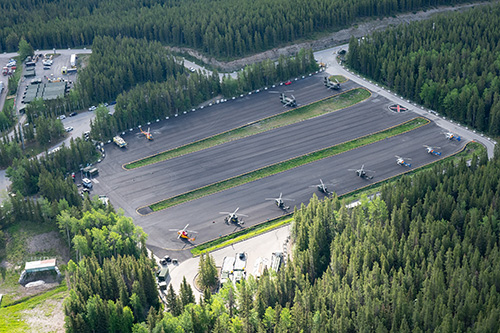Operation CADENCE: RCAF secures airspace for G7 Summit
August 1, 2025 - Defence Stories
Estimated read time – 2:15
Captain Nabil Allou - Public Affairs Officer, Air Task Force - Operation CADENCE

Caption
With the Alberta Rockies as a natural backdrop, members of the Air Task Force from Operation CADENCE gathered at the helicopter landing site in Nakiska for a group photo. At the center stands Staff Sergeant Andrew Kyle, Site Commander of the Temporary Accommodation Facilities of the Royal Canadian Mounted Police. Standing alongside him is the Air Task Force Command Team, Colonel Steeve Belley and Chief Warrant Officer Hugo Prud’Homme.
Photo credit: Sergeant Steeve Picard, June 19, 2025, Kananaskis, Alberta.
From June 15 to 17, 2025, Canada hosted the G7 Leaders’ Summit in Kananaskis, Alberta - a high-profile international event requiring complex security coordination.
Operation CADENCE represented the support of the Canadian Armed Forces (CAF) to the security effort of the Integrated Safety and Security Group (ISSG) led by the Royal Canadian Mounted Police (RCMP).
It is one of the most significant domestic security operations conducted in Canada during peacetime.
In response to a federal assistance request from the Public Safety Ministry, the CAF provided substantial support through a Joint Task Force. The Air Task Force (ATF) was one of the main components of this commitment, with nearly 400 military personnel deployed.
The mission of the ATF was to provide air mobility, which involved the transport and movement of material, equipment, and personnel in support of the RCMP-led ISSG operations. The ATF’s logistical assistance, initiated well before the summit, enabled the delivery of over 2.2&nsp;million pounds of equipment to Alberta, spread across about fifty loads.
To this end, the Royal Canadian Air Force (RCAF) deployed several aircraft platforms, including:
- Six CH-146 Griffon tactical utility transport helicopters and six CH-147 Chinook multi-mission helicopters from 1 Wing;
- Two CH-146 Griffon helicopters from 3 Wing Combat Support Squadron; as well as
- A long-range TPS-77 radar from 4 Wing.

Caption
Aerial view of the Air Task Force helicopter landing site during Operation CADENCE in Nakiska. Several aircraft are visible, including CH-146 Griffon tactical utility transport helicopters, CH-147 multi-role helicopters, as well as AS350 and H145 helicopters from the Royal Canadian Mounted Police. In the upper left portion of the picture, the Air Task Force headquarters can also be seen.
Photo credit: Sergeant Steeve Picard, June 14, 2025, Kananaskis, Alberta.
Additionally, the 4th Artillery Regiment (General Support) of the Royal Canadian Artillery provided three AN/MPQ-504 medium-range radars contributing to air surveillance effort.
Continuing the legacy forged and passed on during the 2018 G7 Leaders’ Summit in Charlevoix, 2 Wing played a central role in conducting air operations under the command of Colonel Steeve Belley. Accordingly, the Mission Support Element, Operations Support Element, Expeditionary Air Management Section, Force Protection Section, and Headquarters were all mobilized from the Wing’s various squadrons.
“I am very proud to have participated in the G7 Summit for the second time in my career. It is impressive to see the progress made since the last edition in Charlevoix and how our collective expertise in air security, essential for an event of this scale, has been strengthened. I would like to thank our colleagues from the Land Task Force, the Joint Task Force, and the Royal Canadian Mounted Police for their exceptional collaboration throughout the operation,” emphasized Colonel Belley, commander of the ATF.

Caption
Aerial view of the site and headquarters of the Air Battalion of the Air Task Force during Operation CADENCE. Visible is a CC-330 Husky, a long-range transport aircraft of the Royal Canadian Air Force, positioned in front of CH-147 Chinook multi-role helicopters. In this context, the CC-330 Husky was used to transport the Prime Minister of Canada, the Right Honourable Mark Carney, to Calgary International Airport (YYC) for the G7 Leaders’ Summit in Kananaskis, Alberta.
Photo credit: Sergeant Steeve Picard, June 16, 2025, Calgary, Alberta.
Operation CADENCE, in its 2025 edition, was once again crowned with success, both for the ATF and all of its partners. It highlights the importance of the continuous modernization of the RCAF’s capabilities, as well as the effectiveness of interoperability between military components and with civilian agencies. More importantly, it demonstrates the CAF’s capacity to support complex security operations on national territory and the ability to jointly face future challenges and projects.